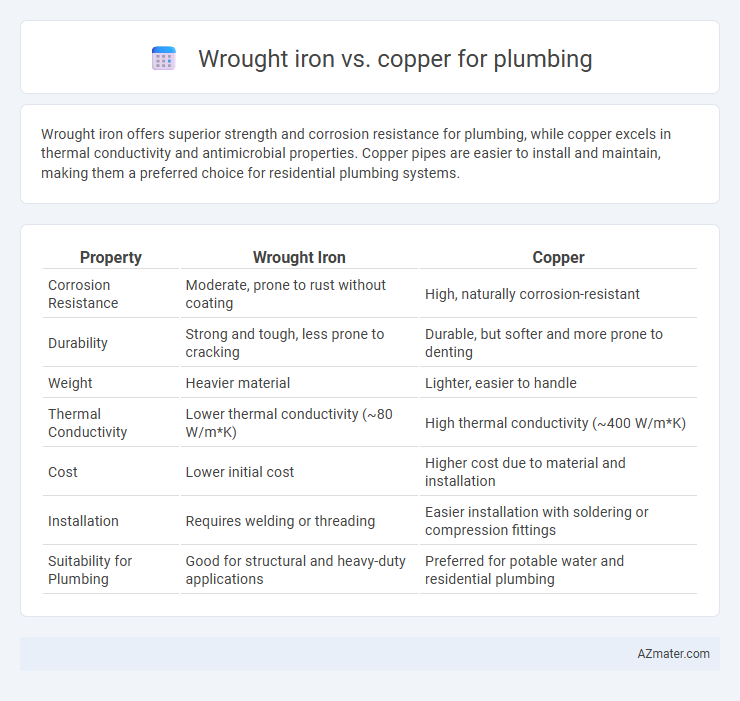Wrought iron offers superior strength and corrosion resistance for plumbing, while copper excels in thermal conductivity and antimicrobial properties. Copper pipes are easier to install and maintain, making them a preferred choice for residential plumbing systems.
Table of Comparison
| Property | Wrought Iron | Copper |
|---|---|---|
| Corrosion Resistance | Moderate, prone to rust without coating | High, naturally corrosion-resistant |
| Durability | Strong and tough, less prone to cracking | Durable, but softer and more prone to denting |
| Weight | Heavier material | Lighter, easier to handle |
| Thermal Conductivity | Lower thermal conductivity (~80 W/m*K) | High thermal conductivity (~400 W/m*K) |
| Cost | Lower initial cost | Higher cost due to material and installation |
| Installation | Requires welding or threading | Easier installation with soldering or compression fittings |
| Suitability for Plumbing | Good for structural and heavy-duty applications | Preferred for potable water and residential plumbing |
Introduction to Wrought Iron and Copper Plumbing
Wrought iron plumbing is known for its exceptional strength, durability, and resistance to corrosion, making it a traditional choice for water and gas pipes. Copper plumbing offers excellent thermal conductivity, natural antimicrobial properties, and is easier to mold and install, which contributes to its widespread use in modern residential and commercial plumbing systems. Both materials deliver reliable performance, but copper's flexibility and corrosion resistance often make it the preferred option in contemporary plumbing applications.
Historical Use of Wrought Iron and Copper Pipes
Wrought iron pipes were widely used in plumbing systems from the mid-19th century through the early 20th century due to their durability and resistance to corrosion, making them a staple in historical municipal water and gas distribution. Copper pipes began gaining popularity in the early 20th century, prized for their superior corrosion resistance, malleability, and antibacterial properties, eventually replacing wrought iron in most residential and commercial plumbing applications. The transition from wrought iron to copper marked a significant advancement in plumbing technology, improving water quality and system longevity.
Material Properties Comparison: Strength and Durability
Wrought iron offers superior tensile strength and excellent resistance to mechanical stress, making it highly durable for plumbing systems exposed to high pressure and physical impact. Copper provides outstanding corrosion resistance and maintains structural integrity over time, especially in environments prone to moisture and temperature fluctuations. While wrought iron is robust against external forces, copper's longevity in preventing leaks and avoiding internal degradation ensures reliable plumbing performance.
Corrosion Resistance: Wrought Iron vs. Copper
Copper exhibits superior corrosion resistance compared to wrought iron, as it naturally forms a protective oxide layer that prevents rust and degradation over time. Wrought iron, while durable, is more prone to rust and requires regular maintenance or protective coatings to withstand corrosive environments. The inherent ability of copper to resist corrosion makes it a preferred material for plumbing systems, especially in areas with high moisture or corrosive water conditions.
Installation Process and Ease of Use
Wrought iron plumbing requires heavy-duty tools and skilled labor for cutting, threading, and assembling, making installation time-consuming and complex. Copper plumbing offers greater ease of use with its lightweight, flexible pipes and compatibility with soldering or push-fit fittings, allowing quicker and more straightforward installation. Copper pipes also provide better maneuverability in tight spaces, reducing labor costs and installation time compared to wrought iron.
Cost Analysis: Initial and Long-term Expenses
Wrought iron plumbing features higher initial costs due to labor-intensive installation and material expenses, but offers exceptional durability and low maintenance over decades. Copper pipes incur moderate upfront costs with easier installation, while long-term expenses may rise due to susceptibility to corrosion and potential replacement needs. Analyzing total cost of ownership, wrought iron can be more cost-effective long-term despite greater initial investment, whereas copper presents lower entry costs but potentially higher lifetime maintenance.
Health and Safety Concerns
Wrought iron plumbing pipes are prone to rust and corrosion, which can lead to iron contamination in the water supply and potential health risks such as bacterial growth. Copper pipes offer superior antimicrobial properties and resist corrosion, reducing the risk of metal leaching and ensuring safer drinking water. However, excessive copper exposure can cause gastrointestinal issues, so maintaining proper water pH and flow is essential for health and safety.
Environmental Impact and Sustainability
Wrought iron and copper differ significantly in environmental impact and sustainability in plumbing applications. Copper offers high recyclability and longevity, reducing the need for frequent replacement and lowering resource consumption, while its mining and extraction process, however, can be energy-intensive and environmentally disruptive. Wrought iron, although less common today, is durable and can be recycled, but its production often involves higher carbon emissions and limited reuse compared to copper, making copper the more sustainable choice overall.
Common Applications in Modern Plumbing
Wrought iron is primarily used in older plumbing systems for its durability and corrosion resistance, commonly found in decorative pipes and structural supports, while copper is favored in modern plumbing for its excellent thermal conductivity, ease of installation, and resistance to biofilm formation. Copper pipes are extensively used in residential water supply lines, heating systems, and refrigerant lines due to their flexibility and longevity. Wrought iron, although less common today, remains in use for specific industrial applications requiring high strength and impact resistance.
Conclusion: Choosing Between Wrought Iron and Copper
Choosing between wrought iron and copper for plumbing depends on factors such as durability, corrosion resistance, and installation cost. Copper offers superior corrosion resistance, longevity, and ease of installation, making it a preferred choice for residential and commercial plumbing systems. Wrought iron, while strong and durable, is prone to rust and requires regular maintenance, making it less ideal for most modern plumbing applications.

Infographic: Wrought iron vs Copper for Plumbing
 azmater.com
azmater.com